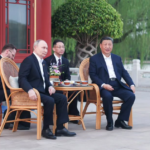BY definition a Metropolis is a large city or conurbation which is a significant economic, political, and cultural centre for a country or region, and an important industrial / commercial hub. A big city belonging to a larger urban agglomeration, but which is not the core of that agglomeration, is not generally considered a metropolis but a part of it.
Edict of Chandigarh as set by Le Corbusier at the foundation of the City in 1950 reads thus: “The city of Chandigarh is planned to human scale. It puts us in touch with the infinite cosmos and nature. It provides us with places and buildings for all human activities by which the citizens can live a full and harmonious life. Here the radiance of nature and heart are within our reach.” The edict was meant to enlighten the present and future citizens of Chandigarh about the basic concepts of planning of the city, so that they become its guardians and save it from individualistic whims.

The last thing Le Corbusier wanted was for Chandigarh to become a Metropolis and, worse, a part-Metropolis. This is what he said: “People say that life must come in the city from other source or activity especially industry. An industrial city is not the same as an administrative city. One must not mix the two…. We must take care that any temptations do not kill the goal, which was foreseen at the moment of the foundation of the city.”
It was to prevent such temptations and retain the natural character and ambience of the city that The Punjab New Capital (Periphery) Control Act, 1952, was enacted to declare a 10 mile (16 km) periphery around Chandigarh as controlled area wherein “no person shall erect or re-erect any building or make or extend any excavation, or lay out any access to a road save in accordance with the plans and restrictions and with the previous permission of the Deputy Commissioner in writing.”
TILL the time Chandigarh remained a part of pre-reorganised Punjab (1966) and some years thereafter this was strictly adhered to. But soon after construction spree took over with two civilian—Mohali and Panchkula—and one military—Chandimandir—townships coming up right on the periphery. From ‘City Beautiful’ Chandigarh became ‘Tri-City’.
There were serious protests, some led by late MN Sharma, Corbusier’s pupil and Union Territory’s first chief architect. He launched a campaign against gross violation of Periphery Control Act which posed a threat to the original character of Chandigarh. According to him, there is very little land left for future growth and it should be prudent that all major projects be evaluated and put through rigorous scrutiny of high-level technical experts. Sharma pointed out that periphery of 10 miles around the city was created for agrarian functions of poultry farming, dairy farming and agriculture. He insisted that the sanctity of the periphery cannot be violated, otherwise confusion and anarchy are sure to follow.
All these fell on deaf ears. What is worse, the ‘Tri-City’ is fast morphing into a ‘Hydra-City’ that may turn into an embodiment of chaos and anarchy. This is the message that came across in the Punjab government’s recent decision to create another township on 5,350 acres in Mohali, called Aerotropolis, in the vicinity of the international airport by acquiring agricultural land in fourteen villages through a pooling policy.
Besides Mohali, these will be eight independent townships being developed by Punjab around ‘City Beautiful’ after Knowledge City, Aerocity, IT City, EcoCity, EduCity, MediCity and New Chandigarh. To make this happen farmers are being offered seductive packages to abandon farming in favour of cement and concrete. For this purpose, proportion of commercial area has been enhanced and the demand of farmers for cash compensation has been met. There are also additional attractions such as allotting plots in the same sector/zone from where the land is acquired and higher share of commercial area for landowners if they so desired.
Now it is reported that two new townships are ready to live in at ‘New Chandigarh’, next to the PGI towards Baddi in Himachal Pradesh. Spread over 806 acres in the foothills of the Shivaliks, Eco City-I and Eco City-II have been developed by the Greater Mohali Area Development Authority. This will extinguish whatever ‘agrarian functions’ left on the periphery of ‘Old Chandigarh’!
INDIA’S first Prime Minister Jawaharlal Nehru had envisaged Chandigarh as “a new town, symbolic of the freedom of India, unfettered by the traditions of the past.” The city is to be a model for India’s urban planning and development in total consonance with nature and with least disruption to agriculture. It was never conceived and designed to be “a big city belonging to a larger urban agglomeration or a Metropolis” Chandigarh is fast losing its core and eminence as the “City Beautiful” and is just becoming part of a chaotic urban agglomeration. Nehru, Corbusier and Sharma must be turning in their graves!
It in this context that one should look at Chief Minister of Punjab, Captain Amarinder Singh, writing to the Union Home Minister seeking restoration of Chandigarh to Punjab. According to him, the long-drawn dispute is still pending and even the fine balance in sharing officers/officials and other resources of Union Territory (UT), Chandigarh between Haryana and Punjab is being disturbed in the recent past. And he accuses the Union Ministry of Home Affairs of inducting more officers of UT cadre into the administration of Chandigarh “without realising the implications of such avoidable decisions.”
Chandigarh UT came into existence on November 1, 1966, under Section 4 of The Punjab Reorganisation Act. As per the original arrangement, a Chief Commi-ssioner of the UT, appointed by the Government of India, was the head of the Chandigarh administration, performing the functions of the Chief Administrator. By appropriate notifications, all the concerned acts and rules of Punjab were made applicable to Chandigarh UT in the same form and substance. The Chief Architect and Chief Engineer continued in the same capacities, with additional responsibility as Secretaries to these respective Departments. The Estate Officer was additionally designated as Deputy Commissioner of the UT. New posts of Home Secretary and Finance Secretary were created to assist the Chief Commissioner.
CHANDIGARH, the only well-planned green-field city in the country, was developed in a systematic and organised manner. The legal framework for the city was set in place in 1952 by enacting the Capital of Punjab (Development and Regulation) Act. This was followed in the same year by framing the Punjab Capital (Development and Regulation) Building Rules, the Chandigarh (Sale of Sites) Rules and the promulgation of the Chandigarh Trees Preservation Order. Also, the Punjab New Capital (Periphery) Control Act was enacted to control and regulate construction at the periphery of the city up to a distance of 16 km in all directions.

Under the provisions of these acts and rules, an institution known as the Capital Project Organisation (CPO) was set up, with full administrative and technical components, and clear-cut functions in the areas of architecture and urban planning, engineering, estate management, and finance. The Chief Administrator was the head of the CPO, with a chief architect, chief engineer, and estate officer looking after their respective functions. The CPO was a non-elected organisation but performed the functions of both project development and local administration and had a fair amount of autonomy.
The Chief Administrator was vested with powers to frame by-laws and issue instructions regarding building, land use, sale of developed plots, preservation of trees, regulation of outdoor advertisements, peripheral control, and other related matters. Implementation of these was the responsibility of the Estate Officer, who was also the administrator of the capital project.
As per the practice prevailing at our time Chief Commissioner (IAS) came from outside both cadres. Out of the other four IAS Officers two (Finance Secretary and Deputy Secretary) came from Punjab and two (Home Secretary and Deputy Commissioner) came from Haryana. Various departments were distributed among these officers. The lone IPS Officer (Senior Superintendent of Police) came from UT Cadre. There was also a mixture of Punjab and Haryana Civil Service Officers. The two technical chiefs (Chief Engineer and Chief Architect) came from Punjab and Haryana. Indeed, there was a fine balance.
Chandigarh Administration then was lean and thin. Now it has become over-bloated and top heavy. Number of IAS Officers has grown from 5 to 13 out of which 8 are from UT Cadre, 3 from Punjab and two from Haryana. From just one there are now 7 IPS Officers. One does not know the number of departments, agencies, boards and corporations that have mushroomed over time to ‘administer’ a city of just around 1.2 million people. Most of the top officials are imported from outside Punjab and Haryana. Hence the loss of balance and this is what needs to be addressed.
Instead the Chief Minister is asking for Chandigarh to be handed over to Punjab. This is both archaic and unrealistic and there are sound reasons to say so. In the last over five decades, two generations have grown up seeing Chandigarh as a distinct territorial entity. As a matter of fact, Shah Commission appointed for the purpose of reorganising Punjab awarded Chandigarh to Haryana, but due to dispute it was made into a UT, serving as the common capital of the two states with the intention of giving it to Punjab at a later stage. Initially, this arrangement was for a period of 10 years, but Government of India has been extending it continuously. Now it is more than half a century, with the golden jubilee already celebrated.
In 1984, the Governor of Punjab was designated as the ‘Administrator’ of the Union Territory and the post of the Chief Commissioner was reduced to that of ‘Adviser to the Administrator’. This was a temporary arrangement to facilitate the coordination of anti-militant/disturbed area operations in Punjab in the wake of Operation Bluestar at the Golden Temple, Amritsar. Though these ‘operations’ have ceased decades ago, typical of India’s governance lethargy this ‘temporary arrangement’ has almost become permanent with Punjab developing a huge vested interest in Chandigarh.

SOME months ago, central government decided to delink the Punjab Governor from administering Chandigarh and appoint an independent administrator, with the rank and status of Lieutenant Governor. But as quickly as it was taken, the decision was rescinded under intense pressure from the former Punjab Chief Minister who was apprehensive about the loss of Punjab’s claim over the city, particularly when the State assembly was facing elections. The Punjab Governor continues to be the Administrator.
Now the present Chief Minister wants Chandigarh back to Punjab as one of its many cities or perhaps as a Metropolis. This certainly is not the solution. As it is with the kind of ‘urban sprawl’ happening all around the city, particularly on the Punjab side, Chandigarh is choking and is running out of breath. Loading it more would take away the very charm and legacy of the city.
Better option would be for the Centre along with Punjab and Haryana State governments to develop it into a ‘knowledge-cum-sports-city’ taking advantage of the available infrastructure and talent. This could also partly realise the dream of Le Corbusier, the founder-architect of the ‘City-Beautiful’!
Writer is a former Army and IAS Officer



























































